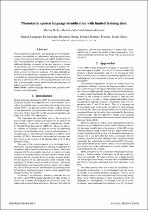JavaScript is disabled for your browser. Some features of this site may not work without it.
- ResearchSpace
- →
- Research Publications/Outputs
- →
- Journal Articles
- →
- View Item
| dc.contributor.author |
Peche, M

|
|
| dc.contributor.author |
Davel, MH

|
|
| dc.contributor.author |
Barnard, E

|
|
| dc.date.accessioned | 2008-12-04T13:41:23Z | |
| dc.date.available | 2008-12-04T13:41:23Z | |
| dc.date.issued | 2007-08 | |
| dc.identifier.citation | Peche, M, Davel, M and Barnard, E. 2007. Phonotactic spoken language identification with limited training data. Interspeech, Antwerp, Belgium, 27-31 August 2007, pp 4. | en |
| dc.identifier.uri | http://hdl.handle.net/10204/2657 | |
| dc.description.abstract | The authors investigate the addition of a new language, for which limited resources are available, to a phonotactic language identification system. Two classes of approaches are studied: in the first class, only existing phonetic recognizers are employed, whereas an additional phonetic recognizer in the new language is created for the second class. It is found that the number of acoustic recognizers employed plays a crucial role in determining the recognition accuracy for the new language. The authors study different approaches to incorporating a language for which audio-only data is available (no pronunciation dictionaries or transcriptions) and find that if more than about 2 000 training utterances are available, a bootstrapped acoustic model for the new language can improve accuracy substantially | en |
| dc.language.iso | en | en |
| dc.subject | Spoken language identification | en |
| dc.subject | Acoustic recognizers | en |
| dc.subject | Resource scarce languages | en |
| dc.title | Phonotactic spoken language identification with limited training data | en |
| dc.type | Article | en |
| dc.identifier.apacitation | Peche, M., Davel, M., & Barnard, E. (2007). Phonotactic spoken language identification with limited training data. http://hdl.handle.net/10204/2657 | en_ZA |
| dc.identifier.chicagocitation | Peche, M, MH Davel, and E Barnard "Phonotactic spoken language identification with limited training data." (2007) http://hdl.handle.net/10204/2657 | en_ZA |
| dc.identifier.vancouvercitation | Peche M, Davel M, Barnard E. Phonotactic spoken language identification with limited training data. 2007; http://hdl.handle.net/10204/2657. | en_ZA |
| dc.identifier.ris | TY - Article AU - Peche, M AU - Davel, MH AU - Barnard, E AB - The authors investigate the addition of a new language, for which limited resources are available, to a phonotactic language identification system. Two classes of approaches are studied: in the first class, only existing phonetic recognizers are employed, whereas an additional phonetic recognizer in the new language is created for the second class. It is found that the number of acoustic recognizers employed plays a crucial role in determining the recognition accuracy for the new language. The authors study different approaches to incorporating a language for which audio-only data is available (no pronunciation dictionaries or transcriptions) and find that if more than about 2 000 training utterances are available, a bootstrapped acoustic model for the new language can improve accuracy substantially DA - 2007-08 DB - ResearchSpace DP - CSIR KW - Spoken language identification KW - Acoustic recognizers KW - Resource scarce languages LK - https://researchspace.csir.co.za PY - 2007 T1 - Phonotactic spoken language identification with limited training data TI - Phonotactic spoken language identification with limited training data UR - http://hdl.handle.net/10204/2657 ER - | en_ZA |






